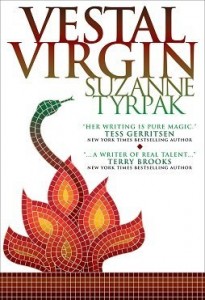 Relevant History welcomes historical suspense author Suzanne Tyrpak, who ran away from New York a long time ago to live in Colorado. Her debut novel, Vestal Virgin: Suspense in Ancient Rome, is set in Rome at the time of Nero, and Tess Gerritsen says, “Her writing is pure magic.” “Pure comedic brilliance” is how J.A. Konrath describes Suzanne’s collection of nine short stories, Dating My Vibrator. And Scott Nicholson says, “Enter this circus and let Suzanne show you why horror is the greatest show on earth” of Ghost Plane and Other Disturbing Tales. For more information, check her blog, and follow her on Facebook and Twitter.
Relevant History welcomes historical suspense author Suzanne Tyrpak, who ran away from New York a long time ago to live in Colorado. Her debut novel, Vestal Virgin: Suspense in Ancient Rome, is set in Rome at the time of Nero, and Tess Gerritsen says, “Her writing is pure magic.” “Pure comedic brilliance” is how J.A. Konrath describes Suzanne’s collection of nine short stories, Dating My Vibrator. And Scott Nicholson says, “Enter this circus and let Suzanne show you why horror is the greatest show on earth” of Ghost Plane and Other Disturbing Tales. For more information, check her blog, and follow her on Facebook and Twitter.
*****
Vestal Virgins have always been surrounded by mystery. We’ve heard the term “Vestal Virgin”—Procol Harum sings about them—but who were they? Priestesses of old who protected the sacred flame of the Roman goddess of the hearth, Vesta—in many ways this celibate sisterhood might be considered forerunners to the nuns of the Catholic Church.
 Vestal Virgins were the most powerful women in the Roman Empire. At a time when women had few rights and were treated like property, Vestal Virgins were revered. Unlike other Roman women, vestals were highly educated. And, although they lived a cloistered life, they had considerable freedom and participated in the world in ways denied to other women.
Vestal Virgins were the most powerful women in the Roman Empire. At a time when women had few rights and were treated like property, Vestal Virgins were revered. Unlike other Roman women, vestals were highly educated. And, although they lived a cloistered life, they had considerable freedom and participated in the world in ways denied to other women.
To be chosen a Vestal Virgin was a great honor, and candidates were usually daughters of leading Roman families. Only six women were designated as priestesses of Vesta, including the Vestal Maxima, who served as the head priestess, similar to a Mother Superior. When a position became available, a number of girls were nominated, but only one candidate was chosen by lottery. Vestals had to be free of physical imperfections, both parents had to be alive, and the girls (usually age six through ten) had to be virgins.
Though most women were completely dependent on men and could own no property, Vestal Virgins had financial independence. They could own property, and the state paid them substantial salaries. Though most Roman women weren’t taught to read or write, Vestal Virgins were highly literate. They scribed many legal documents, and important texts from throughout the empire were kept within the House of the Vestals.
The vestals wielded political and religious influence. They served as members of the Collegiate of Pontiffs, religious advisors to the Roman Senate. After the time of Julius Caesar, the head of the Collegiate of Pontiffs, the Roman Emperor was also appointed Pontifex Maximus. Consequently, the Vestal Virgins were in close contact with the emperor.
The vestals performed many public rituals and sacrifices throughout the year. For example: the harvest festival of Meditrinalia included a chariot race that began at dawn. The victor’s horse was sacrificed, its entrails smeared upon the altar of the Regia, where the Collegiate of Pontiffs resided. It was the job of the vestals to collect blood from the severed genitals to be used the following spring in order to ensure protection of flocks of sheep.
The priestesses of Vesta were believed to hold great power, therefore their blessings were solicited. People gave offerings to the priestesses to ensure that their loved ones would be included in the vestals’ prayers.
A privilege denied to most women was the popular entertainment of gladiator games. Chariot races took place in the morning, and women were welcome to attend, but afternoon brought games that ended in brutal death. The arena was cleared of women—except for the Vestal Virgins. In fact, the priestesses were designated their own box at the Circus Maximus, and the Coliseum, just below the emperor’s box.
Vestals were considered sacrosanct, and a vestal’s word was considered sacred. At times, her word could override an emperor’s. For example: a prisoner, sentenced to death, might escape his fate if pardoned by a Vestal Virgin.
 The six Vestal Virgins are, perhaps, best known for tending the sacred fire which represented the heart of Rome. Once a year, the fire was allowed to burn out. It would then be rekindled in a ritual, using a clear crystal and the rays of the sun.
The six Vestal Virgins are, perhaps, best known for tending the sacred fire which represented the heart of Rome. Once a year, the fire was allowed to burn out. It would then be rekindled in a ritual, using a clear crystal and the rays of the sun.
Because they tended the fire sacred to Vesta, virgin goddess of the hearth, the priestesses had to remain pure, and consequently vestals were pledged to thirty years of chastity on penalty of death. If suspected of breaking her vow, a vestal would face a trial with the Collegiate of Pontiffs and punishment to be doled out by the Pontifex Maximus. She might be tested in a variety of ways. For example: a vestal might be given a sieve in which she had to carry water from the Tiber river. No doubt, cheating did take place—smearing the sieve with grease might provide a way around the test. Or a vestal might be thrown into the river: if she sank, she would be considered pure, and, if she swam, she would be proved tainted—a test reminiscent of the much-later Salem witch trials. Once found guilty, a vestal would usually be sentenced to death. First, hair shorn and dressed in a drab robe instead of finery, she would be paraded through the streets, as if she were already dead. She would then be entombed alive with scant provisions and left to asphyxiate.
Of course, there were exceptions—not necessarily for the better. The emperor, Nero, for example, held himself above the law and is known to have raped at least one Vestal Virgin. The family name she bore was Rubria, but that is all we know of her. This gave me ample leeway, as a writer of fiction, to write my novel, Vestal Virgin: Suspense in Ancient Rome.
After serving for thirty years, Vestal Virgins were free to leave the order, but at a time in history when women were valued mostly for childbearing and life expectancy was short, what fate could a woman hope for in her late thirties? A vow of chastity might be a demanding price, but the rewards were great. Because of the power and freedom granted Vestal Virgins, rather than go to live with a male relative, many priestesses chose to remain in service.
*****
 A big thanks to Suzanne Tyrpak. She’ll give away one electronic copy of Vestal Virgin to someone who contributes a comment on my blog this week. I’ll choose the winner from among those who comment by Saturday at 6 p.m. ET.
A big thanks to Suzanne Tyrpak. She’ll give away one electronic copy of Vestal Virgin to someone who contributes a comment on my blog this week. I’ll choose the winner from among those who comment by Saturday at 6 p.m. ET.
**********
Did you like what you read? Learn about downloads, discounts, and special offers from Relevant History authors and Suzanne Adair. Subscribe to Suzanne’s free newsletter.

Thanks for joining us today, Suzanne. Fascinating essay, especially the parallel you drew between the “testing” of the vestals and suspected “witches” in Colonial America.
Thanks for inviting me, Suzanne
If anyone happens to be going to Rome, the House of the Vestals was recently reopened. Please stop in, and say hi for me!
Just saw your comment. Yes, interesting how they were throwing Vestals into the water to see if they sank or swam, etc. Also, a lot of parallels between the Vestals and later Christian nuns.
Wow! So many things I didn’t know. Thanks! (I always wondered about my husband’s aunt’s name. Her name was Vesta. I had never heard of it before I met him.)
Codes of Ur-Nammu and Hammurabi provided for trial by ordeal with water.
http://home.comcast.net/~burokerl/water_torture.htm
http://en.wikipedia.org/wiki/Trial_by_ordeal
Also, interesting to explore connection of vestals and Greek priestesses, such as Pythia:
http://en.wikipedia.org/wiki/Pythia
Liz
Suzanne, I think you need to stop in at the House of the Vestals and give them an autographed copy of your book.
Nuns and monks in the very earliest Christian Church weren’t expected to toe the line on celibacy; that came later. But I wonder whether frolicking in later days ever got a nun cast out.
Valerie, thanks for stopping by. You see, this is why you need to keep coming back here. Forget about The History Channel. lol
Thanks for the links, Liz!
@Valerie. Vesta is the goddess of the hearth–simular to the Greek goddess, Hestia.
@Liz–thanks for the links!
@Suzanne, I didn’t know that early Christian monks and nuns didn’t have to be celibate. No wonder Christianity caught on–must have been some great parties…
Suzanne, the party period didn’t last long, and historians seem eager to gloss over that phase, go figure.
Ah, the things we were never taught in our Latin classes Thank you to both Suzannes for a most interesting post.
Thank you to both Suzannes for a most interesting post.
Kathy
Thanks for stopping by, Kathy. Alas, they don’t teach about Vestal Virgins in Latin class, and they yank all the fun parts out of History class. The fun parts make it relateable, relevant.
I’ve forwarded the link to my Latin prof husband. Maybe he can be a trend setter! I know I’ve seen Vestal Virgins in other mysteries set in Rome, but no one– to my knowledge, anyhow– has focused on them. For the (rather harsh) treatment of unchaste Catholic nuns in the 15th century, see Margaret Frazer’s Apostate’s Tale. Rather than a nice quick entombment, they seem to have gone for bread & water and penance– lots of penance…
Your summary does suggest a lot of ideas for mysteries, doesn’t it? Fascinating peak into history, Suzanne! Thank you!
Nice to see you here, Lin! Yeah, time on the knees is definitely rough, especially on a stone floor or the bare ground. After a few hours, the wayward nun probably wished she’d been entombed.
Welcome back, Lea! I haven’t yet read Suzanne’s book, but I can think of several cool mystery ideas that an author could spin off the concepts in her essay. A “Locked Tomb” mystery is one. There’s so much in history to stimulate the imagination.
Thanks Lin. A few books mention the Vestals or use them as a backdrop, but I haven’t found other fiction focused on them. When I began the book, a few years back, very little had been written about them.
I love finding obscure women in history and writing their stories. My next book, Agathon’s Daughter, is a trilogy set in ancient Greece–suspense, because suspense is entertaining, but I’ve done a lot of research. Part one focuses on the hetaerae — consorts/courtesans. They were the most powerful women in Athens and attended symposiums when other women were cloistered. I bring in Aspasia, consort to Pericles, the head stateman of Athens in the classic period. She had quite an influence on him and, consequently, politics. Part One will be out late fall.
@Lea, thanks for posting. Yes, mystery, intrigue, all that good stuff.
It’s been awhile since I’ve been a virgin, Vestal or otherwise, but I’m looking forward to reading Tyrpak’s book! Lately I’ve become interested in Roman history — my specialty being American colonial history, and by the way, witches were not given the water test in
Salem. That seems to have been a Great Britain thing. Witches were given a legal trial in Salem — you may not agree with the verdict, but there you are. The courts later exonerated them all, which people forget.
Marilyn aka: M. E. Kemp, author of the Two Nosy Puritans
series, in one of which, DEATH OF A BAWDY BELLE, my detective is accused of being a witch.
Marilyn, thanks for setting the record straight about the witchcraft furor in America v. Britain. And I remember another difference. They didn’t burn “convicted” witches in America.
Fascinating stuff! I hopped over from Robin Sullivan’s blog after your comment there.
Welcome, Susan, and thanks for stopping by. Suzanne sure has made the topic of Vestal Virgins intriguing, hasn’t she? It’s giving a lot of us ideas. Thanks for signing in to my blog. To see more of the fun parts of history, the stuff they left out in History class, click on the Relevant History category in the sidebar and read what other unruly topics have been discussed here.
Thanks for signing in to my blog. To see more of the fun parts of history, the stuff they left out in History class, click on the Relevant History category in the sidebar and read what other unruly topics have been discussed here.
@Susan and Marilyn.
Very interesting, Marilyn — I’m going to check out Bawdy Belle! I didn’t know that about witches in Salem. How were they punished, if not burned?
@Suzanne A – these relevant history posts from different authors are fascinating – what a great idea for your blog!
About early Christians not being celibate – Peter Tremayne’s Sister Fidelma mysteries are set in I think 7th – or maybe 9th? century Ireland, at a time when the differences between the Celtic church and the Roman one are coming to a head. Tremayne’s main character, Sister Fidelma, gets married at some point in the series. Gives some fascinating perspective. Tremayne is the pseudonym of Peter Berresford Ellis, who writes nonfiction as well.
Suzanne, most “convicted” witches in the Salem trials were hanged. A man was squashed to death beneath a plank that had been piled with rocks.
Hi Mary, thanks for chiming in. YES! Thanks so much for mentioning the Sister Fidelma series. I’ve been trying to think of the author’s name all day, and I knew it wasn’t Margaret Frazer. Anyone who’s reading this and interested in learning about a time when celibacy wasn’t the rule of the Church, find Peter Tremayne’s Sister Fidelma mysteries.
And I’m so glad you’re enjoying these posts, Mary.
eeewww I’d rather be hanged than squashed.
When I was a child, I read a book in which the main character had to carry water in a sieve. It was my first encounter with the Vestals, and that image stayed with me for years. I was in my fifties before I found out that the practice was real. I’d always thought of it as fiction of the highest order. Thank you for bringing this all back to life yet again!
Thanks again, Suzanne, for inviting me. Great group of posters on your blog. I look forward to visiting again!
I’ve been fascinated by ancient Rome for decades and have read a lot of original sources (albeit in translation). There really is not a lot about the Vestals, however!
Re “pressing” vs hanging in Salem:
Convicted witches (those who did not confess but claimed innocence of witchcraft and where then convicted by the religious trial) were hanged.
Confessed witches were given their lives but were stripped of all property and turned out to “wander the high road.”
Those who would answer neither “aye” nor “nay” to their accusers were pressed in order to force a confession or denial out of them.
The most famous Salem resident (and I believe the only one) to be pressed was Giles Corey. He was a cantankerous old man but he loved his family and so would not answer his accusers, even when large rocks were placed on the planks atop his prone body.
Eventually the weight killed him (chest compression = inability to breathe) but his family kept his land.
(Those who enjoy drama should read Arthur Miller’s The Crucible for a dramatic version. DO NOT SEE THE MOVIE which distorts both the play and the historical record.)
@Fran, how interesting that your remember that story from childhood–I wonder where you heard it.
@Mari, fascinating information. And I remember The Crucible from years ago–I think we performed it in school at some point.
Always interesting to see information on powerful women through the ages (isn’t it funny how even today, there is a part of society that doesn’t agree women can be equal to men?).
Also interesting that only when they remained virgins could they keep their power; giving your maidenhead also gives away your brainpower???? whoa…
Hi Linda, I’m glad you stopped by. What I’ve found fascinating is how, through the centuries, women have been accumulating power here and there, wherever they could, and up until recently, the women with the most power were the ones who weren’t married. For example, an Abbess in the Middle Ages, or a widow during the Revolutionary War. Notice how in “The Wizard of Oz” the villain is wealthy spinster Elmira Gulch who later morphs into the Wicked Witch. And in “The Sound of Music,” when the nuns ask, “How do you solve a problem like Maria?” they wind up marrying Maria off to Captain von Trapp. Historically, people in a number of cultures have exhibited suspicion and fear when faced with independent, single women for at least four thousand years.
Hmmmm…so, Suzanne–nothing’s really changed, has it? People still want to marry off powerful, single women. Oh, wait…maybe that’s just my family!
Suzanne, the more I learn about history, the more I see that nothing changes.